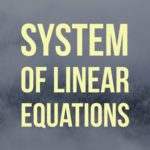The Possibilities For the Number of Solutions of Systems of Linear Equations that Have More Equations than Unknowns

Problem 295
Determine all possibilities for the number of solutions of each of the system of linear equations described below.
(a) A system of $5$ equations in $3$ unknowns and it has $x_1=0, x_2=-3, x_3=1$ as a solution.
(b) A homogeneous system of $5$ equations in $4$ unknowns and the rank of the system is $4$.
(The Ohio State University, Linear Algebra Midterm Exam Problem)
 Add to solve later
Add to solve later
Sponsored Links
Contents
Hint.
See the post Summary: possibilities for the solution set of a system of linear equations to review how to determine the number of solutions of a system of linear equations.
Solution.
Let $m$ be the number of equations and $n$ be the number of unknowns in the given system.
Note that the information $m > n$ tells us nothing about the possibilities for the number of solutions.
(a) A system of $5$ equations in $3$ unknowns and it has $x_1=0, x_2=-3, x_3=1$ as a solution.
The system has at least one solution $x_1=0, x_2=-3, x_3=1$, hence it is consistent.
Thus, the system has either a unique solution or infinitely many solutions. Since $m > n$, we cannot narrow down the possibilities further. Thus, the possibilities are either a unique solution (which must be $x_1=0, x_2=-3, x_3=1$) or infinitely many solution.
(b) A homogeneous system of $5$ equations in $4$ unknowns and the rank of the system is $4$.
Since the system is homogeneous, it has always the zero solution, hence it is consistent.
The fact $m > n$ gives no new information. But since the rank $r$ of the system is equal to the number of unknowns $n$, there is no free variable. ($n-r=0$.) Thus, the system must have a unique solution, which is the zero solution.
Comment.
This is one of the midterm exam 1 problems of linear algebra (Math 2568) at the Ohio State University.
Some students wrongly concluded from the condition $m >n$. Again, note that the condition $m > n$ gives no new information at all.
Midterm 1 problems and solutions
The following list is the problems and solutions/proofs of midterm exam 1 of linear algebra at the Ohio State University in Spring 2017.
- Problem 1 and its solution (The current page): Possibilities for the solution set of a system of linear equations
- Problem 2 and its solution: The vector form of the general solution of a system
- Problem 3 and its solution: Matrix operations (transpose and inverse matrices)
- Problem 4 and its solution: Linear combination
- Problem 5 and its solution: Inverse matrix
- Problem 6 and its solution: Nonsingular matrix satisfying a relation
- Problem 7 and its solution: Solve a system by the inverse matrix
- Problem 8 and its solution:A proof problem about nonsingular matrix
 Add to solve later
Add to solve later
Sponsored Links
















7 Responses
[…] Problem 1 and its solution: Possibilities for the solution set of a system of linear equations […]
[…] Problem 1 and its solution: Possibilities for the solution set of a system of linear equations […]
[…] Problem 1 and its solution: Possibilities for the solution set of a system of linear equations […]
[…] Problem 1 and its solution: Possibilities for the solution set of a system of linear equations […]
[…] Problem 1 and its solution: Possibilities for the solution set of a system of linear equations […]
[…] Problem 1 and its solution: Possibilities for the solution set of a system of linear equations […]
[…] Problem 1 and its solution: Possibilities for the solution set of a system of linear equations […]